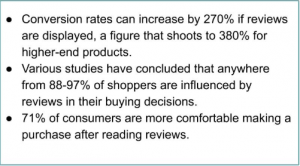Data and analytics provide ample information regarding what your customers are looking for in your business. But sometimes it may not be enough. It is better to ask the customers directly and get straight answers. Technically, this is referred to as customer feedback. But why do we need it? Customer feedback helps in understanding why people are preferring one feature over others or why a customer stops using certain products/services. Well-curated reviews are a clear witness for current and potential clients that an organization understands industry trends, as well as the needs of their customers.
According to a BrightLocal survey conducted in 2018, more than 78 percent of customers, (out of which 91% fall in the 18-34 age group), treat online reviews at par with personal recommendations. Besides this, a HubSpot study revealed that a mere 3% of customers trust marketers and sales reps.
This indicates the pivotal role played by review in the sales funnel, keeping in mind the satisfaction levels of end-users. It marks the trust associated with a brand, product, and service, considering the statistics mentioned below.

We all know that analyzing customer feedback is extremely important for improving the quality of service. But extracting the feedback from customers is a challenge for most companies. The reason being customers are not always willing to give feedback as they may face hectic work schedules or other obligations. Here, I have discussed a few ways to approach your customers for honest feedback.
- Focus Group: Focus group comprises of few people selected purposefully to participate in a scheduled discussion, which generates customer perceptions regarding a service or product. Contrary to interviews, members of focus groups interact with each other and share their respective perceptions and ideas. It happens in series and utilizes qualitative methods of data collection. The participants can influence each other’s decisions. Focus groups are mostly used during the initial phases of product planning and clustering requirements to derive feedback about products, users, concepts, prototypes, strategies, tasks, and environments. A prototype gives a clear idea to users regarding each stage of the product design and development process, which helps a brand know whether they identified the requirements correctly.
- Customer Surveys: Perhaps the most convenient way to gather customer feedback is through context-driven surveys across different channels – email, homepage, social platforms, or mobile. Besides several benefits associated with customer surveys, one key advantage is that they are quite useful for accumulating customer knowledge over a period. Surveys help in gaining customer loyalty, as customers get to realize the importance of their opinions in the decision-making process of a business. Here, I have discussed two commonly used techniques for conducting customer surveys:
- Send email newsletter: Sending an email is used most frequently to request customer feedback. This email is usually sent post service is availed or a product is bought by a customer. For example, when you purchase a dress online or stay at a resort, the respective company or booking agency asks you to rate your experience and give positive feedback.
- Monitor social channels: Social listening is a powerful technique for securing information about a particular brand on social media. You can promote your products and services, new launches, awards and recognition, and upgradations so that more people come to know about your achievements. Few tools also aid in monitoring the activities of your peers on social media. Sites such as LinkedIn, Twitter, and Facebook offers a platform where customers can share their experiences, post photos, and express dissatisfaction about a particular product/service. In the case of negative comments, you need to promptly resolve the issue and calm down annoyed customers.

- Usability Testing: This technique is used to see the feasibility of some service/product by testing it on real users. Users are requested to evaluate a product while being monitored by researchers, who note down any problems encountered during the process. These observers monitor many such users and if they also face similar problems then they propose suggestions to overcome usability issues.
- Customer reviews: You can optimize your blog posts, websites, emails, mobile pages, and social profiles so that your customers can leave their reviews quickly and easily. These reviews are gathered either using public forums, third-party review sites or privately by the company.
We recently received the Clutch award as a top development company in the US. A few of our esteemed customers have reviewed our services – web development, custom software development, and app development. To know in detail, visit https://clutch.co/profile/people10-technologies.
5. Analyze recorded sales calls: The outbound sales team within a company make several hundred calls daily. These call logs can be used both for training purposes as well as for deriving feedback for your service. Even though they haven’t tried your product/service, their feedback about your company’s profile may be useful for creating an everlasting impression on potential customers.
Conclusion:
Gathering customer feedback is a crucial aspect of any business process. But it should be done ethically, for if you fail to comply with the guidelines for gathering solicit reviews, you may have to face serious action and other severe consequences. You can abide by the following rules to protect yourself from any ethical breach:
- Don’t send bulk emails to customers requesting reviews. You should only ask for a review in case there has been a genuine transaction.
- You can’t ‘bribe’ or incentivize your customers for reviews as it reflects a biased approach. It distorts the results and is highly unethical.
- You can’t force the customer to give positive feedback always, you must be open to negative feedback as it provides you an opportunity to improve your service quality. Your main intention should be to help solve your customer’s issues and queries so that they are happy with your offerings.
- You must avoid posting reviews on behalf of customers on third party websites. Any feedback should come directly from customers.
- Don’t collect data which may be an intrusion to customer’s privacy
For questions regarding your business process and product development, contact us at info@people10.com.




